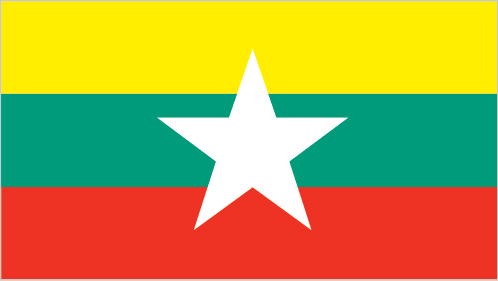Capital City: Rangoon (Yangon)
Population: 55,746,253 (July 2014 est)
Currency: Kyats pronounced chats (MMK)
Land Area: 676,578 sq km. Strategic location near major Indian Ocean shipping lanes
Dominant Religions: Buddhist 89%, Christian 4% (Baptist 3%, Roman Catholic 1%), Muslim 4%, Animist 1%, other 2%
Land Boundaries: Bangladesh 193 km, China 2,185 km, India 1,463 km, Laos 235 km, Thailand 1,800 km
Location: Southeastern Asia, bordering the Andaman Sea and the Bay of Bengal, between Bangladesh and Thailand
Climate: Tropical monsoon; cloudy, rainy, hot, humid summers (southwest monsoon, June to September); less cloudy, scant rainfall, mild temperatures, lower humidity during winter (northeast monsoon, December to April)
Terrain: Central lowlands ringed by steep, rugged highlands
Visa: Visa must be obtained in advance of arrival. Myanmar embassy in Bangkok is open 09:00-12:00 and 15:30-16:30. Directly in front of the embassy is a small copy service (well marked, you can’t miss it), where you can buy visa application form for just 5THB or/and make a copy of your photo page of your passport (3THB), which is required. **Bring a pen. Officials are helpful and friendly. If applying for tourist visa, fill-in your application (you can also get it for free from embassy at Counter 4). Paste one photo. Attach one extra photo (they supply paper clips at Counter 4 as well) and the copy of the photo page from your passport. Submit completed application at counter 4 and save the token number you get from the official. Wait until they call you. The next step is payment. Official will tell you which day you can collect your passport and give you receipt.
Entry Point: Myawaddy (from Mae Sot, Thailand) or Kawthoung (from Ranong, Thailand) – You can now cross this border and travel into Myanmar. You can continue by bus, boat or plane into the rest of the country. Permission of Entry into and Departure from Myanmar – Thai Border Gates
Exit Point: A land border crossing exists between Tamu (Myanmar) and Moreh (India). While there have been confirmed reports of some travellers crossing into Myanmar from India, with their own transport as well as with permits arranged in advance, the general consensus is that obtaining all the necessary permits is very hard. At the least, a foreigner (a person who is neither a citizen of India nor a citizen of Myanmar) will need to get an Indian permit to visit the state of Manipur, and an MTT permit to enter or leave Myanmar at Tamu. Travellers may also need a permit to travel from Tamu to Kalewa, although there are unconfirmed reports that this is no longer required.
Special Notes: Myanmar’s infrastructure is in poor shape. As a result of the political situation, Myanmar is subject to trade sanctions from much of the western world, and this can cause problems for unwary travelers. Travel to certain regions is prohibited; for others, special permits must be obtained, and a guide/interpreter/minder may be mandatory – although whether these “guides” accompany you to look after you, or to keep you from going to places the government doesn’t want you to see, is moot.
Cuisine: Burmese food is a blend of Chinese, Indian and Mon influences. Rice is at the core of most Burmese food, and good vegetarian food is widely available. Some types of traditional Burmese food can be extremely pungent, but a lot of restaurants serve dishes with strong Indian and Chinese influences, so if you are comfortable with those, you won’t have much trouble. Food is inexpensive at most restaurants (costing from MYK500-3000 per item at most local restaurants, but can go as high as MYK8000 at posh restaurants), but there are upscale restaurants in Yangon and Mandalay for upmarket food.

